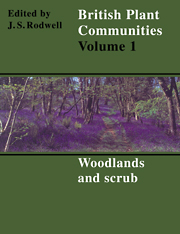Book contents
- Frontmatter
- Contents
- List of Figures
- Foreword
- Preface and Acknowledgements
- Preamble
- General Introduction
- Woodlands and Scrub
- Introduction to Woodlands and Scrub
- Key To Woodlands and Scrub
- Community Descriptions
- W1 Salix Cinerea-Galium Palustre woodland
- W2 Salix Cinerea-Betula Pubescens-Phragmites Australis Woodland
- W3 Salix Pentandra-Carex Rostrata Woodland
- W4 Betula Pubescens-Molinia Caerulea Woodland
- W5 Alnus Glutinosa-Carex Paniculata Woodland
- W6 Alnus Glutinosa-Urtica Jzozca Woodland
- W7 Ainus Glutinosa-Fraxinus Excelsior-Lysimachia Nemorum Woodland
- W8 Fraxinus Excelsior-Acer Campestre-Mercurialis Perennis Woodland
- W9 Fraxinus Excelsior-Sorbus Aucuparia-Mercurialis Perennis Woodland
- W10 Quereus Robur-Pteridium Aquilinum-Rubus Fruticosus Woodland
- W11 Quereus Petraea-Betula Pubescens-Oxalis Acetosella Woodland
- W12 Fagus Sylvatica-Mercurialis Perennis Woodland
- W13 Taxus Baccata Woodland
- W14 Fagus Sylvatica-Rubus Fruticosus Woodland
- W15 Fagus Sylvatica-Deschampsia Flexuosa Woodland
- W16 Quereus spp.-Betula spp.-Deschampsia Flexuosa Woodland
- W17 Quereus Petraea-Betula Pubescens-Dicranum Majus Woodland
- W18 Pinus Sylvestris-Hylocomium Splendens Woodland
- W19 Juniperus Communis Ssp. Communis-Oxalis Acetosella Woodland
- W20 Salix Lapponum-Luzula Sylvatica Scrub
- W21 Crataegus monogyna-Hedera helix scrub
- W22 Prunus Spinosa-Rubus Fruticosus Scrub
- W23 Ulex Europaeus-Rubus Fruticosus Scrub
- W24 Rubus Fruticosus-Holcus Lanatus Underscrub
- W25 Pteridium Aquilinum-Rubus Fruticosus Underscrub
- Index of Synonyms to Woodlands and Scrub
- Index of Species in Woodlands and Scrub
- Bibliography
W16 - Quereus spp.-Betula spp.-Deschampsia Flexuosa Woodland
Published online by Cambridge University Press: 04 July 2020
- Frontmatter
- Contents
- List of Figures
- Foreword
- Preface and Acknowledgements
- Preamble
- General Introduction
- Woodlands and Scrub
- Introduction to Woodlands and Scrub
- Key To Woodlands and Scrub
- Community Descriptions
- W1 Salix Cinerea-Galium Palustre woodland
- W2 Salix Cinerea-Betula Pubescens-Phragmites Australis Woodland
- W3 Salix Pentandra-Carex Rostrata Woodland
- W4 Betula Pubescens-Molinia Caerulea Woodland
- W5 Alnus Glutinosa-Carex Paniculata Woodland
- W6 Alnus Glutinosa-Urtica Jzozca Woodland
- W7 Ainus Glutinosa-Fraxinus Excelsior-Lysimachia Nemorum Woodland
- W8 Fraxinus Excelsior-Acer Campestre-Mercurialis Perennis Woodland
- W9 Fraxinus Excelsior-Sorbus Aucuparia-Mercurialis Perennis Woodland
- W10 Quereus Robur-Pteridium Aquilinum-Rubus Fruticosus Woodland
- W11 Quereus Petraea-Betula Pubescens-Oxalis Acetosella Woodland
- W12 Fagus Sylvatica-Mercurialis Perennis Woodland
- W13 Taxus Baccata Woodland
- W14 Fagus Sylvatica-Rubus Fruticosus Woodland
- W15 Fagus Sylvatica-Deschampsia Flexuosa Woodland
- W16 Quereus spp.-Betula spp.-Deschampsia Flexuosa Woodland
- W17 Quereus Petraea-Betula Pubescens-Dicranum Majus Woodland
- W18 Pinus Sylvestris-Hylocomium Splendens Woodland
- W19 Juniperus Communis Ssp. Communis-Oxalis Acetosella Woodland
- W20 Salix Lapponum-Luzula Sylvatica Scrub
- W21 Crataegus monogyna-Hedera helix scrub
- W22 Prunus Spinosa-Rubus Fruticosus Scrub
- W23 Ulex Europaeus-Rubus Fruticosus Scrub
- W24 Rubus Fruticosus-Holcus Lanatus Underscrub
- W25 Pteridium Aquilinum-Rubus Fruticosus Underscrub
- Index of Synonyms to Woodlands and Scrub
- Index of Species in Woodlands and Scrub
- Bibliography
Summary
Synonymy
Oak-birch-heath association Moss et al. 1910, Tansley 1911; Quercetum ar enosum roburis et sessiliflorae Tansley 1911 p.p.; Quercetum ericetosum Tansley 1911, 1939; Quercetum sessiliflorae Moss 1911, 1913 p.p.; Dry oak-birchwood Hopkinson 1927p.p.; Southern Pennine oakwoods Scurfield 1953 p.p.; Oakwoods Pigott 1955 p.p.; Quer co-Betuletum Klötzli 1970 p.p.; Oakwoods Rackham 1980 p.p.; Birchwoods Rackham 1980p.p.; Birch-oak woodland Peterken 1981 p.p.; Birch woodland Peterken 1981 p.p.; Woodland plot type 18 Bunce 1982 p.p.
Constant species
Betula pendula/pubescens, Quercus petraea/robur, Deschampsia flexuosa, Pteridium aquilinum.
Physiognomy
The Quercus spp.-Be tula spp.-Deschampsia flexuosa woodland is a much less species-rich and less variable community than its mixed deciduous counterparts and much less complicated by the effects of treatment. In essence, these are oak-birch woodlands: oak and birch are very much the most frequent trees throughout and the usual dominants, alone or in mixtures. Both species of oak are well represented, their distribution showing the same general pattern as in the Quercus-Pteridium-Rubus woodland. Quercus robur predominates over most of the southerly parts of the range, apart from those striking enclaves, such as parts of the Weald, south-east Essex and Sherwood Forest in Nottinghamshire, where it is partly replaced by Q. petraea and hybrids (Jones 1959, Gardiner 1974). In these areas, the favouring of Q. robur as the plantation oak and the greater facility with which it colonises open ground, tend to sharpen up the difference between older stands, many of which are coppiced, with Q. petraea, and younger stands with Q. robur, a feature reflected in the views of Rackham (1980) on East Anglian examples of this kind of woodland. Towards the north-western fringes, Q. petraea prevails almost exclusively, even in younger tracts.
Oak can dominate here in high-forest canopies which are virtually closed, though the trees are not always tall, especially in more exposed sites at higher altitudes along the Pennine fringes (e.g. Moss 1911, 1913, Scurfield 1953, Pigott 1955). A complete cover of oak is also characteristic of some plantation stands included here. Quite commonly, however, the oak canopy is somewhat open, not only in younger woodlands where colonisation is not far advanced, but also in wood-pasture stands, in which form this community makes an important contribution to the landscape of some of our older Forests like Sherwood (Hopkinson 1927), Epping and parts of the New Forest (Tubbs 1968, Rackham 1980, Peterken 1981) and smaller parks like Staverton (Peterken 1969).
- Type
- Chapter
- Information
- British Plant Communities , pp. 263 - 277Publisher: Cambridge University PressPrint publication year: 1991



